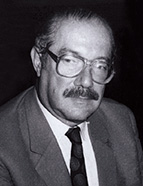

Manuel Farinha dos Santos, an archaeologist, prehistorian, university professor, museologist, and heritage expert, was born on 24 August 1923 in the Penha de França parish, Lisbon, and passed away there on 29 September 2001. The son of a militiaman engineering lieutenant and mechanical engineer who graduated from the Instituto Superior Técnico, and a former student of the Piano Course at the Conservatório Nacional de Lisboa [National Conservatory in Lisbon], M. Farinha dos Santos lost his father at the age of 10 and his mother at 15. Raised by his maternal grandparents until his late teens, he was immersed in the literary world inherited from his paternal grandfather, a republican hero, which instilled in him a love for literature and history. His family’s financial struggles, however, compelled him to work as a tutor, and by the age of 16, he was employed as a typist in a downtown office, followed by various other jobs and military service (Elogio do Prof. Dr. [Eulogy of Prof. Dr.], 2013, 16-17).
M. Farinha dos Santos completed his seventh year at Liceu Camões [Camões High School], where he excelled in Literature. At 19, he enrolled as a voluntary student in the Historical-Philosophical Sciences degree at the Faculdade de Letras de Lisboa [ School of Arts & Humanities] (FLUL). Four years later, he married Esmeralda Farinha dos Santos, with whom he had two children. He studied Arabic and Sanskrit at the Instituto de Línguas Orientais da Escola Superior Colonial [Institute of Oriental Languages of the Colonial College], fraternised with poets, joined the Grupo Coral do Clube da Estefânia [Choir of the Estefânia Club], and dedicated himself to the study of religions.
This additional training proved essential for fulfilling his mission when he headed the maritime services at the Port of Lisbon from 1953 to 1954. He then departed on a commission to Portuguese India, where he stayed for two years, volunteering for the mission to establish a brigade of the Polícia Internacional e de Defesa do Estado [International and State Defence Police] (PIDE), which he had joined in 1947 after completing his military service as an ensign (A História da PIDE [The History of PIDE], 2007) and was hired in 1949 as the brigade chief. It was there in the Orient, as a PIDE sub-inspector, that he deepened his interest in archaeology. He spent time consulting the library of the archaeological section at the Biblioteca do Instituto Vasco da Gama de Goa [Vasco da Gama Institute Library in Goa] (established in 1871) and reading specialised books lent to him by his friend Panduronga Pissurlencar (1894-1969), the director of the Historical Archives of the State of India (Elogio do Prof. Dr., 2013, 18-19).
This work is financed by national funds through FCT - Foundation for Science and Technology, I.P, in the scope of the projects UIDB/04311/2020 and UIDP/04311/2020.
